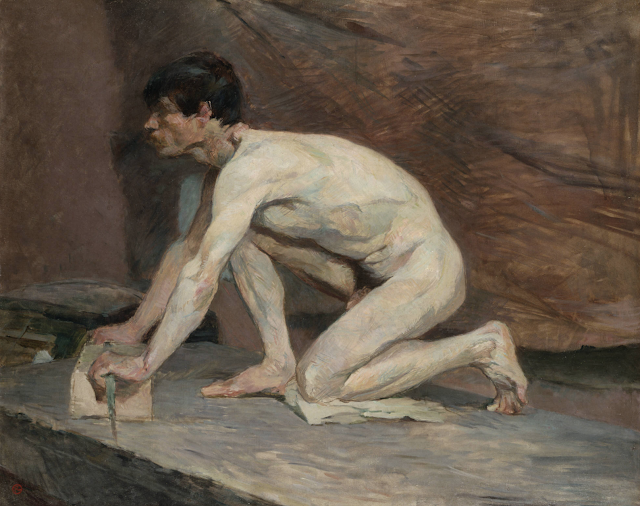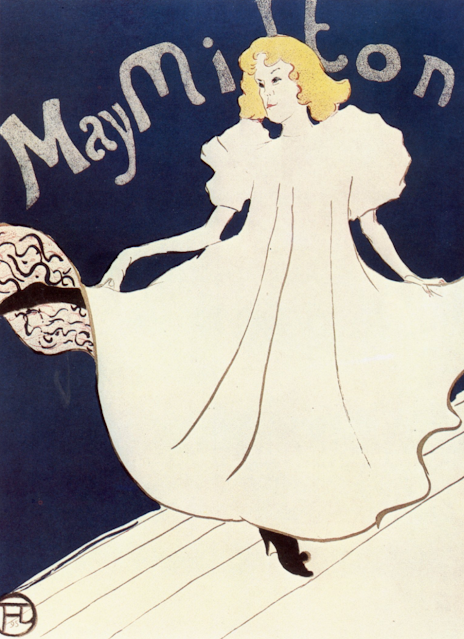Henri de Toulouse-Lautrec
was a French painter, printmaker, draughtsman, caricaturist and illustrator whose immersion in the colorful and theatrical life of Paris in the late 19th century allowed him to produce a collection of enticing, elegant, and provocative images of the modern, sometimes decadent, affairs of those times.
Toulouse-Lautrec is among the best-known painters of the Post-Impressionist period, with Paul Cézanne, Vincent van Gogh, Paul Gauguin and Georges Seurat.
In a 2005 auction at Christie's auction house, La Blanchisseuse, his early painting of a young laundress, sold for US$22.4 million and set a new record for the artist for a price at auction.
Born into the aristocracy, Toulouse-Lautrec broke both his legs around the time of his adolescence and, due to an unknown medical condition, was very short as an adult due to his undersized legs. In addition to his alcoholism, he developed an affinity for brothels and prostitutes that directed the subject matter for many of his works.
Paris
During a stay in Nice, France, his progress in painting and drawing impressed Princetau, who persuaded Toulouse-Lautrec's parents to let him return to Paris and study under the portrait painter Léon Bonnat. He moved to Paris in 1882. Toulouse-Lautrec's mother had high ambitions and, with the aim of her son becoming a fashionable and respected painter, used their family's influence to get him into Bonnat's studio.
Toulouse-Lautrec was drawn to Montmartre, the area of Paris famous for its bohemian lifestyle and the haunt of artists, writers, and philosophers. Studying with Bonnat placed Toulouse-Lautrec in the heart of Montmartre, an area he rarely left over the next 20 years.
Rise to Recognition
In 1888, the Belgian critic Octave Maus invited him to present eleven pieces at the Vingt (the 'Twenties') exhibition in Brussels in February. Van Gogh's brother Theo bought Poudre de Riz (Rice Powder) for 150 francs for the Goupil & Cie gallery.
From 1889 until 1894, Toulouse-Lautrec took part in the Salon des Indépendants regularly. He made several landscapes of Montmartre. Tucked deep into Montmartre in the garden of Monsieru Pere Foret, Toulouse-Lautrec executed a series of pleasant en plein air paintings of Carmen Gaudin, the same red-headed model who appears in The Laundress.
Interactions with Women
In addition to his growing alcoholism, Toulouse-Lautrec also frequented prostitutes. He was fascinated by their lifestyle and the lifestyle of the "urban underclass" and incorporated those characters into his paintings. Fellow painter Édouard Vuillard later said that while Toulouse-Lautrec did engage in sex with
prostitutes, "the real reasons for his behavior were moral ones ... Lautrec was too proud to submit to his lot, as a physical freak, an aristocrat cut off from his kind by his grotesque appearance. He found an affinity between his condition and the moral penury of the prostitute. "He would frequently visit one located in Rue d'Amboise, where he had a favorite called Mireille. He created about a hundred drawings and fifty paintings inspired by the life of these women. In 1892 and 1893, he created a series of two women kissing called Le Lit, and in 1894 painted Salón de la Rue des Moulins from memory in his studio.
He declared, "A model is always a stuffed doll, but these women are alive. I wouldn't venture to pay them the hundred sous to sit for me, and god knows whether they would be worth it. They stretch out on the sofas like animals, make no demand and they are not in the least bit conceited. "
The Moulin Rouge
When the Moulin Rouge cabaret opened in 1889, Toulouse-Lautrec was commissioned to produce a series of posters. His mother had left Paris and, though he had a regular income from his family, making posters offered him a living of his own. Other artists looked down on the work, but he ignored them. The cabaret reserved a seat for him and displayed his paintings. Among the well-known works that he painted for the Moulin Rouge and other Parisian nightclubs are depictions of the singer Yvette Guilbert; the dancer Louise Weber, better known as La Goulue who created the French can-can; and the much subtler dancer Jane Avril.
Alcoholism
Toulouse-Lautrec was mocked for his short stature and physical appearance, which may have contributed to his abuse of alcohol.
He initially drank only beer and wine, but his tastes expanded into liquor, namely absinthe. The "Earthquake Cocktail" (Tremblement de Terre) is attributed to Toulouse-Lautrec: a potent mixture containing half absinthe and half cognac in a wine goblet. Due to his underdeveloped legs, he walked with the aid of a cane, which he hollowed out and kept filled with liquor in order to ensure that he was never without alcohol.
Art
In a career of less than 20 years, Toulouse-Lautrec created more than 6,000 pieces, some ceramic stained-glass works, and an unknown number of lost works.
His debt tot eh Impressionists, particularly the more figurative painters like Manet and Degas, is apparent, that within his works, one can draw parallels to the detached barmaid at A Bar at the Folies-Bergère by Manet and the behind-the-scenes ballet dancers of Degas. His style was also influenced by the classical Japanese wood prints, which became popular in art circles in Paris.
Toulouse-Lautrec's skilled depiction of people relied on his painterly style, which is highly linear and emphasizes contour. He often applied paint in long, thin brushstrokes, which would leave much of the board underneath showing through the paint. Many of his works may be best described as "drawings in coloured paint."
On 20 August 2018, Toulouse-Lautrec was the featured artist on the BBC television program Fake or Fortune? Researchers attempted to discover whether he created who discovered sketchbooks.
Death
By February 1899, Toulouse-Lautrec's alcoholism began to take its toll and he collapsed from exhaustion. His family had him committed to Folie Saint-James for three months. While he was committed, he drew 39 circus portraits. After his release, he returned to the Paris studio for a time a then traveled throughout France. His physical and mental health began to decline rapidly owing to alcoholism and syphilis, which he reportedly contracted from Rosa La Rouge, a prostitute who was the subject of several of his paintings.
On 9 September 1901, at the age of 36, he died from complications due to alcoholism and syphilis at his mother's estate, Château Malromé, in Saint-André-du-Bois. He is buried in Cimetière de Verdelais, Gironde, a few kilometers from the estate. His last words reportedly were "Le vieux con!" ("The old fool!"), his goodbye to his father, though another version has been suggested, in which he used the word "hallali," a term used by huntsmen at the moment the hounds kill their prey: "Je savais, Papa, que vous ne manqueriez pas l'hallali." ("I knew, papa, that you wouldn't miss the death.")




















































Comments
Post a Comment